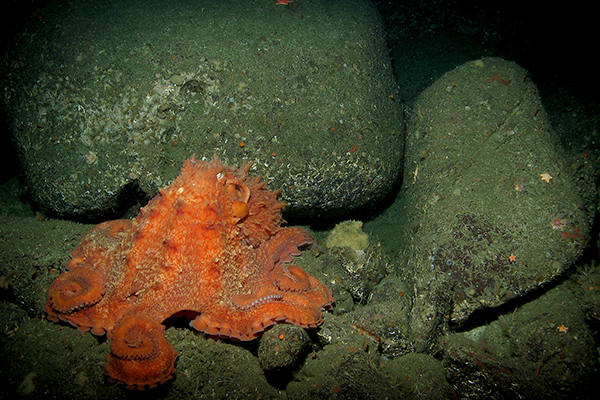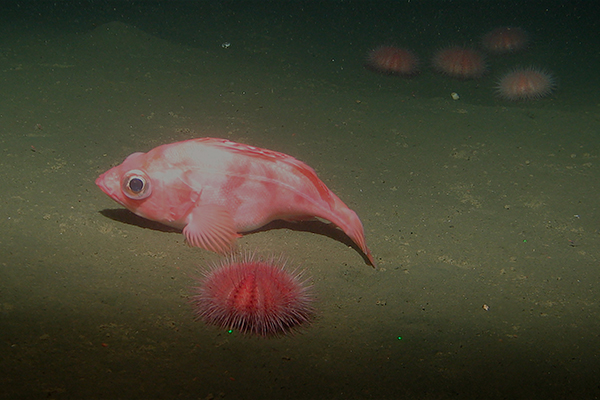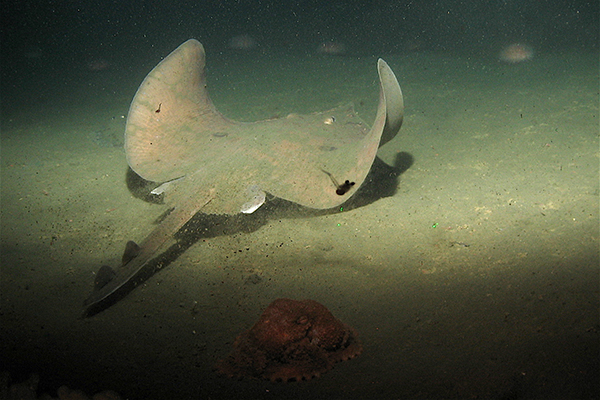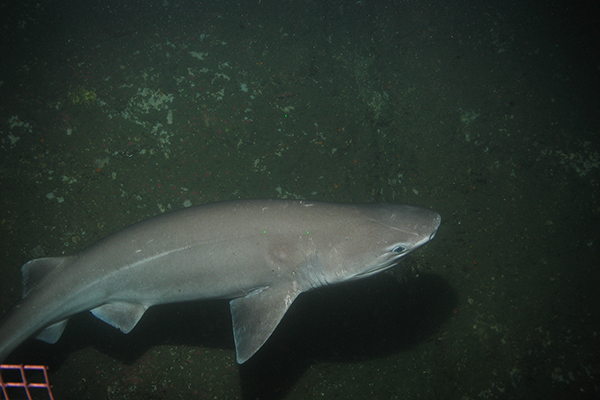Searching for the treasures of the deep: Deep-sea corals and sponges in national marine sanctuaries
By Sarah Marquis
July 2018 (updated September 2018)
Deep-sea corals and sponges are some of the oldest animals on Earth, living for hundreds of years at depths that defy direct human observation. Coral, sponge, and fish communities thrive in the cold, deep waters off California’s coast, but are rarely – if ever – visited or studied.
In August, scientists using advanced technology aboard the NOAA Ship Bell M. Shimada studied unexplored seafloor habitats off North-Central California in NOAA’s national marine sanctuaries. The expedition took place in Cordell Bank and Greater Farallones national marine sanctuaries, and in the northern part of Monterey Bay National Marine Sanctuary, which is under Greater Farallones management. Their focus included coral, sponge, and groundfish communities. What they learned will help inform the management of these special ocean areas, and add to knowledge about deep-sea habitats and the biological communities that live and thrive there.

Remotely operated vehicle
To survey the seafloor and record images of the habitats as deep as 2,000 feet (600 meters), sanctuary scientists and a team from Marine Applied Research & Exploration (MARE) used a remotely operated vehicle (ROV), Beagle. The ROV was launched from the ship and sent into the depths of the ocean.
The uncrewed ROV transmitted real-time video and images via a cable connected to the ship. Grabber arms on the ROV collected geological and biological specimens.
Thirty-one specimens were sampled for identification, including several species that had never been previously documented in these national marine sanctuaries. Highlights included abundant and diverse invertebrate communities. Researchers witnessed a sixgill shark, deep-sea sharks known as catsharks, and many rockfish, flatfish, and skates. Many species of deep-sea corals were observed, including one or more that may be undescribed species to date. Researchers also observed some corals that are known in southern areas but were documented for the first time in these waters.
Scientists also conducted seafloor mapping. Scientists use mapping data to understand the finer details on the seafloor, which helps to target areas to look for corals and sponges to be explored by deep-water submersibles and robotics. Mapping data are also important tools for research and management of marine areas. In all, approximately 115 square miles of mapping data were collected during this research expedition.

Why go into the deep?
The deep sea is one of our planet's "great unknowns" because it is largely inaccessible to humans. However, it affects us in many ways. A healthy ocean is essential to the health of our planet, and deep-sea communities are important components of marine ecosystems. The deep sea nurtures fish stocks and hosts life-forms like bacteria and sponges that have contributed to medical discoveries.
Coral and sponge habitats are among the most biodiverse and productive ecosystems throughout the entire ocean. Increasing global human demand for resources has created a need for expanded science and conservation of these deep-ocean ecosystems, their living resources, and the benefits they may yield. Both living and dead corals and sponges are “biogenic habitats,” where the organisms themselves provide habitat for other marine life.
Previous NOAA expeditions off California’s coast have identified several new species of corals and sponges, including Swiftia farallonesica, a slender white coral, in the deep waters of the Sonoma County coast in Greater Farallones National Marine Sanctuary. New sponge species were discovered living on the wreck of the USS Independence off the San Mateo County coast. They were also discovered in Cordell Bank National Marine Sanctuary, both in Bodega Canyon and on the deep slope near Cordell Bank to the north. New species discoveries underscore that we still have much to learn about the deep sea.
The ocean supports hundreds of billions of dollars of the U.S. economy through food, jobs, transportation, recreation, and other services. NOAA’s mission is “to understand and predict changes in climate, weather, oceans, and coasts, to share that knowledge and information with others, and to conserve and manage coastal and marine ecosystems and resources.” Assessing the conditions of ocean ecosystems can lead to better management of those areas, both to maintain ocean integrity and health, and to support the ocean economy.

The team
Scientists from NOAA’s Cordell Bank and Greater Farallones national marine sanctuaries and NOAA’s National Centers for Coastal Ocean Science were co-principal investigators. MARE provided the ROV and personnel. Funding and contributions were from NOAA’s Deep Sea Coral Research and Technology Program, NOAA Office of National Marine Sanctuaries, NOAA National Ocean Service, and NOAA Office of Marine and Aviation Operations. Scientists from U.S. Geological Survey, California Academy of Sciences, NOAA’s Office of Coast Survey, and Greater Farallones Association also participated in the mission.

Deep sea in the classroom
Educators! Want to teach about these deep-sea coral communities? Check out the Deep Coral Community Curriculum. This curriculum takes students into the deep sea to identify the soft corals, hard corals, invertebrates, and fish found in these communities and to investigate the unique biology of deep-sea corals.
Bell M. Shimada
The NOAA Ship Bell M. Shimada is operated, managed, and maintained by NOAA's Office of Marine and Aviation Operations, which includes commissioned officers of the NOAA Corps and civilian wage mariners. NOAA's Office of Ocean Exploration and Research operates, manages, and maintains the cutting-edge ocean exploration systems on the vessel and ashore.

Multimedia
Click on images for a higher-resolution, downloadable version. Click the three dots in the lower-right corner of videos to download them.
Sarah Marquis is the West Coast/Pacific media coordinator for NOAA’s Office of National Marine Sanctuaries.






